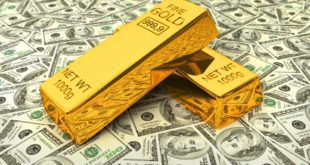What happens when gold has transitions from a cyclical bull market to a cyclical bear  market? What motivates gold to enter a bull market phase? [This article has the answers.]
market? What motivates gold to enter a bull market phase? [This article has the answers.]
The above introductory comments are edited excerpts from an article* by Pater Tenebrarum (ActingMan.com) entitled Gold Stocks and Gold – Potentially Bullish Developments.
The Technicals
How gold stocks are performing relative to gold is extremely important…[and there are some interesting] parallels between the situation of today and that of 1999/2000…particularly the technical aspects…[as shown in the] chart showing the move beginning from the year 2000 low…
 Gold stocks as represented by the HUI index and the HUI-gold ratio, which has just made a new high for the move – click to enlarge.
Gold stocks as represented by the HUI index and the HUI-gold ratio, which has just made a new high for the move – click to enlarge.
The Fundamentals
Regarding the fundamentals, one must keep in mind that gold and gold stocks are highly sensitive to changes in the fundamental backdrop. This is to say, they often reflect future changes in the fundamental situation with a very long lead time. As a result, the long drawn out bottoming action in precious metals and gold stocks in 1999/2000 started while the stock market was still roaring higher and the Fed was actually in tightening mode. Similarly, the decline from the peaks in 2011 and 2012 (apart from the fact that it involved a pricing out of the euro area debt crisis premium) accelerated in 2013, even while the Fed was printing more money than ever before. In recent months, a bottom seems to be in the process of forming while the Fed is actually once again in tightening mode.
The HUI-Gold Ratio
The fact that the HUI-gold ratio is making new highs even while gold and silver are under short term pressure is very important. As always, we must stress that we are only talking about probabilities here, not certainties. However, new bull markets in the sector tend to follow a certain pattern:
- the mining stocks strengthen,
- then gold begins to follow them higher, and
- after a variable, but often long time lag, silver also begins to rise and gain in relative strength.
- Other commodities tend to follow even later.
GDXJ, GDX, gold and silver
The blue quadrangles [above] show that while the metals have returned to the consolidation range of April-June, gold and silver mining stocks have established a higher consolidation range. Moreover, there is now yet another divergence between gold and silver in evidence at the most recent low relative to the preceding low…
Why are these Divergences Occurring?
We now want to briefly turn to the reasoning behind the sequence of events that is usually observed when the precious metals sector bottoms out and turns up. In other words, there are fundamental reasons for the technical divergences mentioned above. In order to understand them, one first needs to consider what happens when gold has transitions from a cyclical bull market to a cyclical bear market.
- During bull markets gold miners begin to mine lower grade portions of their deposits so as to extend the life of mines, which is in principle not a bad approach. However, as gold bull markets mature, mining costs tend to rise ever more, as other commodities prices are usually also rallying strongly at the time. This leads to a sharp rise in input costs, including labor costs (which are a very large part of total costs), for all mining businesses. Pursuing mine plans that include low grade areas of deposits becomes more risky as a result – any unexpected price decline will immediately tend to squeeze margins, and it takes some time to alter mine plans.
- Near the peak of the bull market, the managers of gold mining companies also tend to become careless. Spoiled by high metal prices, they tend to invest large sums in development projects that would at best be considered marginal at lower prices. In other words, a lot of capital tends to get wasted in this phase.
- After the transition to bear market conditions, as a rule not only gold’s nominal price, but also its real price declines noticeably. Margin compression sets in, and a period of losses and write-offs follows, as reserves are re-evaluated to reflect lower prices. Development projects get shelved or downsized, managements are fired and replaced. In short, by the time prices hit their lows, everything has gone fully into reverse and the focus has shifted 180 degrees from production expansion to margin preservation and cost control. In this phase managements act as if they are expecting prices to go still lower, and the market will also tend to discount this possibility. Prices of mining stocks collapse to very low levels relative to metal prices. As we have pointed out late last year already, the market for some time failed to acknowledge a beginning improvement in costs and the first signs of stabilizing margins. The notion that mining costs would just keep rising was firmly entrenched. Around the time when the reversal in costs took place, a great many downgrades were issued, and analysts were spilling a lot of ink on a trend that had already ended.
Consider now what motivates gold to enter a bull market phase.
- Usually this involves a budding decline in economic confidence. Subtle signs of this can usually be detected in other markets; e.g. credit spreads will tend to increase.
- Before nominal gold prices rally, there is usually a reversal in gold’s real price. In other words, the margins of gold mining companies tend to increase even before there is a rise in the nominal gold price, as other commodities and various input prices decline relative to gold. This is why in the early stages of a new cyclical bull market, gold stocks tend to rise relative to the gold price, and will remain in a “sweet spot” in terms of margins for quite some time. Note e.g. in the above mentioned chart of the action from 2000-2002that gold declined for a full four months to a new low for the move between November 2000 and April 2001, while the HUI actually rallied, sending the HUI-gold ratio sharply higher.
 The gold-CCI ratio bottomed in May and has trended upward since then. Moreover, gold stocks have diverged positively against the ratio in late May relative to the December 2013 low in gold-CCI
The gold-CCI ratio bottomed in May and has trended upward since then. Moreover, gold stocks have diverged positively against the ratio in late May relative to the December 2013 low in gold-CCI
The above mentioned process also explains why
- silver tends to underperform in the early stages of a new cyclical gold bull market,
- only bottoms out with a lag and then
- takes longer before it begins to exhibit good performance as well.
Although the two metals are closely correlated, silver has a large industrial demand component in addition to being a monetary metal. Therefore the very things that exert a positive effect on gold stocks and gold in the early stage of the bull market, initially tend to be a drag on silver.
- gold remains fairly expensive relative to commodities, and
- its long term bull market against commodities appears to be intact.
However, the chart also suggests that a retest of the lower of the two trend lines shown cannot be completely ruled out from a technical perspective (file under: potential fly in the ointment).
The secular uptrend in the gold-CCI ratio seems to be intact – click to enlarge.
To summarize the above: if a trend change from bear to bull market in the sector is indeed underway, then we are currently getting all the signals we would expect to see in this case:
- multiple divergences between the sister metals gold and silver at their lows,
- divergences between the mining stocks and the metals,
- divergences of the mining stocks with their momentum oscillators (which were already established at the 2013 lows), and recently
- the strong upturn in relative strength in the mining stocks in the face of a correction in the metals. Moreover, the action fits with a possible road map for the economy and the stock market.
GDM Bullish Percent Index
…GDM is a very broad-based cap-weighted gold and silver mining index containing 29 stocks (very similar to the XAU). The bullish percent index shows the percentage of stocks in the index currently sporting a point & figure buy signal. This index has recently reached a new high for the move as well, which shows that the sector is internally even stronger than the cap-weighted indexes are indicating.
$BPGDM vs. the HUI – the bullish percent index has moved to a new high for the year, indicating growing internal strength – click to enlarge.
Potential Negatives, the Metals and the Dollar
We would be remiss not to mention the potential risks and negatives.
- In the near term, one risk is given by the fact that a number of gold stocks have in the meantime become overbought. This could be alleviated by sector-internal rotation, which is in fact something that has frequently happened during the recent consolidation period.
- Another risk is given by the still relatively large net speculative position in gold futures, which is somewhat balanced by subdued sentiment reflected by surveys. However, gold is relatively close to a support level, so one has to be aware of the potential for a break of this support. It seems possible that a number of long positions have been taken on in reaction to the unstable geopolitical backdrop. This always creates potential downside risk. On the other hand, the recent move lower in gold consisted of overlapping waves and has a wedge-like shape. There is no telling yet which way the cookie will eventually crumble. It remains to be seen how gold stocks will react if that happens (as noted above, in 2000-2001, they weren’t bothered by gold breaking lower over a period of four months).
- A potential danger is also that if there is a stock market decline, it could get out of hand. If the stock market falls slowly, it won’t be a negative for the gold sector, but a very fast and hard decline would probably be a drag.
Both gold and silver remain quite close to important support levels – click to enlarge.
The US Dollar Index
The US dollar index is another conundrum. Its recent rally has been very strong and looks impulsive. It is now overbought and ripe for a pullback and curiously, gold has actually held up very well relative to the dollar. The dollar seems driven by the geopolitical news backdrop to some extent as well, but there is also the perception that…due to economic weakness and a sharp decline in inflation expectations in the euro area, the ECB will be tempted to adopt some form of “QE”. This may not happen right away, but there is a widespread expectation that it will happen sooner or later (the ECB is first likely to await the effect of the TLTROs which are scheduled for September and December though).
 The US dollar index nominal and relative to the dollar gold price. While the rally in the dollar looks quite strong at present, it has not been confirmed by gold.
The US dollar index nominal and relative to the dollar gold price. While the rally in the dollar looks quite strong at present, it has not been confirmed by gold.
Inflation Expectations
In the context of long term inflation expectations (5 to 10 years and longer), it should be mentioned that they are currently declining everywhere. However, nominal bond yields are declining even faster, thus real interest rates are driven lower in spite of the decrease in inflation expectations.
- Falling inflation expectations are generally a negative for gold, at least for its nominal price (not necessarily its real price – that depends on how other prices in the economy are affected).
- On the other hand, falling real interest rates are a bullish factor, so these two factors seem to cancel each other out at the moment (note that “inflation expectations” in this context refers to expectations regarding future CPI rates of change).
Conclusion
Many of the factors that usually signal that the gold sector is likely to strengthen remain in evidence, and have lately become more pronounced again…Since the sector has a tendency to be very volatile, however, short term head fakes in both directions can be expected to happen at any time.
The action following the late 2000 low in the gold stocks probably provides us with a good road map.
- Should gold stocks continue to hold up well relative to gold and silver in the event of a further decline in the prices of the metals, dips should be regarded as buying opportunities.
- Conversely, a significant weakening of the gold stocks on a relative basis would be a warning that the time is not yet ripe for a resumption of the secular bull market.
- Even though gold is close to a support level, gold stocks are close to breaking a level of resistance, so it is once again time to keep a close eye on the action.
Editor’s Note: The author’s views and conclusions in the above article are unaltered and no personal comments have been included to maintain the integrity of the original post. Furthermore, the views, conclusions and any recommendations offered in this article are not to be construed as an endorsement of such by the editor.
*http://www.acting-man.com/?p=32655 – Charts by: StockCharts (Copyright © 2008-2014 acting-man.com – All rights reserved)
If you liked this article then “Follow the munKNEE” & get each new post via
- Our Newsletter (sample here)
- Twitter (#munknee)
 munKNEE.com Your Key to Making Money
munKNEE.com Your Key to Making Money







This article was filled with information but I came away from reading it with the sense that “time will tell” and I already knew that, since for most investors picking the low point is not as important as getting stuck buying in near the high point!
Got physical PM’s?
If so, hold onto them.